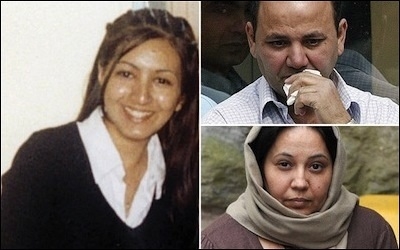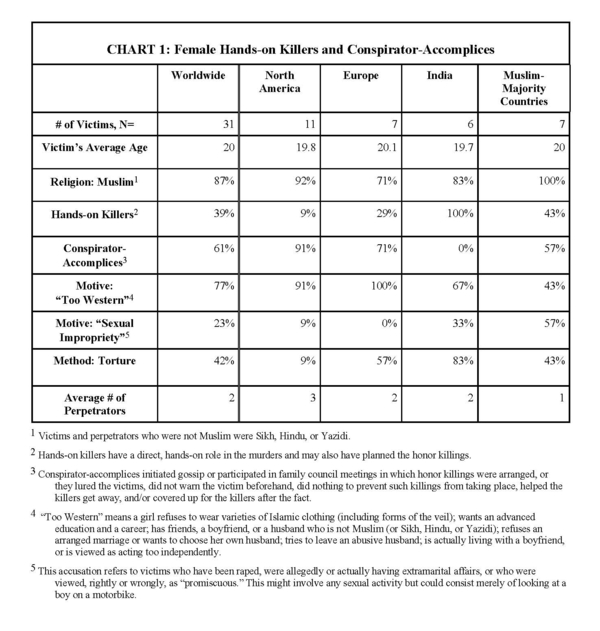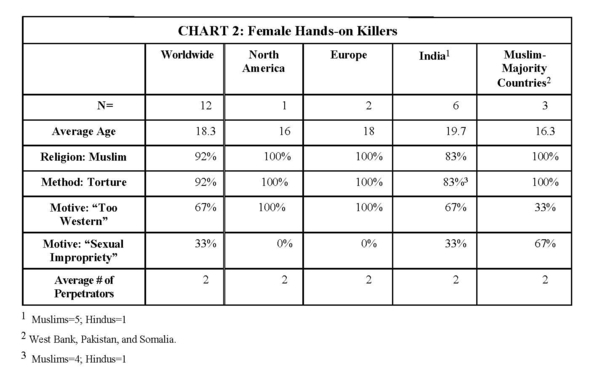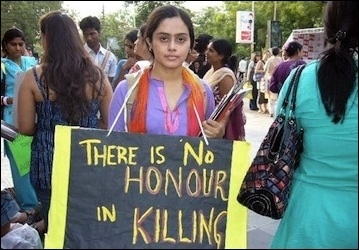 Female perpetrators and accomplices in honor killings, like their male counterparts, can be calculating, brutal, and without remorse. Tooba Yahya Shafia (center) of Canada was directly involved with her husband and son in the murder of three of her daughters and her husband’s first wife. Female perpetrators and accomplices in honor killings, like their male counterparts, can be calculating, brutal, and without remorse. Tooba Yahya Shafia (center) of Canada was directly involved with her husband and son in the murder of three of her daughters and her husband’s first wife.
|
Female-on-female violence has been minimized because male-on-female violence is far more visible, dramatic, and epidemic. However, women sometimes kill infants, spouses, and adult strangers, including other women. Indeed, as this study shows, women play a very active role in honor-based femicide, both by spreading the gossip underlying such murders and by acting as conspirator-accomplices and/or hands-on-killers in the honor killing of female relatives.
A Deeper Look
In order to explore this phenomenon, this author conducted an original, non-random, qualitative study of 31 honor killings (26 cases) in North America, Europe, India, and Muslim-majority countries, where women were named as hands-on killers and/or conspirator-accomplices in the media.
All of these honor killings took place between 1989 and 2013. Eighty-seven per-cent were Muslim-on-Muslim crimes; the remaining 13 percent were committed by Hindus, Sikhs, and Yazidis. Women were hands-on killers in 39 percent of these cases and served as conspirator-accomplices 61 percent of the time. In India, women were hands-on killers 100 percent of the time.[1] (See Chart 1, below.)
Hands-on killers and conspirator- accomplices saw their victims as “too Western” or as “sexually inappropriate.”
|
The average age of all victims was twenty years old. When women were the hands-on killers, the average age of their victims was 18.3; although conspirator-accomplices killed victims whose average age was 21, this age difference was of no statistical significance.[2] (See Chart 2, below.)
Forty-two percent of the honor killings in which women participated were torture-murders. Torture-murders are those in which victims are at-tacked in multiple ways—drugged/poisoned, beaten, tied up, suffocated, wrists or throats slashed, stabbed many times, hacked to death, or burned with acid—in short, victims are subjected to a slow and painful death. However, in the case of female hands-on killers, the victims were torture-murdered 92 percent of the time as compared to women who served as conspirator-accomplices with a male hands-on killer; in that case the torture-murder rate was 11 percent.[3] Torture-murders were most frequent in India[4] (83 percent) and in Europe (57 percent). The rate of torture-murder in Muslim-majority countries was 43 percent while in North America it was 9 percent.
The legal outcomes of 25 of these cases are known: 92 percent led to arrests, trials, and/or convictions. This is not surprising as an arrest is probably what triggered the media coverage that brought these cases to light. However, as with incest and other “hidden” family crimes, only a minority of such cases may attract media or legal attention. One hundred percent (100%) of the female and 90 percent of the male hands-on killers were arrested, tried, and/or convicted. Only 53 percent of the female conspirator-accomplices were arrested, tried and/or convicted. The differential arrest rate for (male and female) hands-on killers vs. (female) conspirator-accomplices was statistically significant (p=0.010).
Hands-on killers and conspirator-accomplices killed for the same reasons: They saw their victims as “too Western” or as “sexually inappropriate.” Motive varied as a function of region. Both hands-on killers and conspirator-accomplices viewed their victims as “too Western” 77 percent of the time. Sixty-seven percent of female hands-on killers and 84 percent of conspirator-accomplices perceived their victims this way. (See Charts 2 and 3, below.) In Muslim-majority countries, only 43 percent of victims were killed for this reason. However, in the West, the mainly Muslim victims in North America were viewed as “too Western” 91 percent of the time and 100 percent of the time in Europe. (See Chart 1 for definitions of “too Western.”)
Twenty-three percent of victims were killed for committing an act of “sexual impropriety.” However, in Muslim-majority countries, 57 percent of victims, and, in predominantly Muslim areas of India, 33 percent of victims, were killed for this reason as compared to only 9 percent in North America; there were no honor killings for this reason in Europe.[5]
The Narratives behind the Facts
The above statistics tell only part of the story. What emerges from the narratives of these cases is that the majority of both hands-on killers and conspirator-accomplices blamed their victims for their gruesome fate and are calculating, cold, and self-righteous women. Both female hands-on killers and conspirator-accomplices physically and verbally abused, monitored, and stalked their victims, warning them of dire consequences if they failed to obey the rules. Some issued clear death threats. A few examples:
 Shafilea Ahmed (left) of the United Kingdom was murdered by her Pakistani father Iftikhar (top right) and mother Farzana (bottom right). They suffocated Shafilea in front of their four other children after she refused a forced marriage in Pakistan. They were convicted and sentenced to life imprisonment.
Shafilea Ahmed (left) of the United Kingdom was murdered by her Pakistani father Iftikhar (top right) and mother Farzana (bottom right). They suffocated Shafilea in front of their four other children after she refused a forced marriage in Pakistan. They were convicted and sentenced to life imprisonment.
On the day Aqsa Parvez, a 16-year-old Pakistani-Muslim-Canadian girl, was killed, her mother said in a police interview that she “thought her husband was only going to ‘break legs and arms,’ but instead [he] ‘killed her straight away.'” Distraught, she said, “Oh God, Oh God…Oh my Aqsa, you should have listened. Everyone tried to make you understand. Everyone begged you, but you did not listen.”[6] Although seemingly in anguish, the mother appears to have had no problem with having her daughter’s bones broken. Aqsa’s father and brother received life sentences with eligibility for parole after 18 years. The mother was not tried.
Shafilea Ahmed was a 17-year-old Pakistani-Muslim-British girl. Her parents carried out her slow suffocation murder in front of their other young children, warning them that they “would be killed if they ever revealed the truth.”[7] Almost a decade later, perhaps fearing for her own life, Shafilea’s sister Alesha approached the police. She said their mother “began the attack with the words ‘Just finish it here.'”[8] During the murder, the mother said to one of her younger daughters, “You will be next” and “Shut up, or you are dead.”[9]
A 19-year-old Indian-Muslim girl, Zahida, was strangled to death by her mother who said, “This should be the treatment meted out to young people from our religion who marry into families of other faiths.”[10] The mother also said that she “killed her because [she] brought shame to our community. How could [she] elope with [a] Hindu? She deserved to die. I have no remorse.”[11]
Noor Almaleki was a 20-year-old Iraqi-Muslim-American living in Arizona. Her father ran her over with a two-ton Jeep Cherokee. When her mother was informed that her daughter was dying, she said, “Thank you, thank you … That’s what she needs.”[12]
Sixteen-year-old Indian-Muslim Rekha Yadav was hacked to death by her mother who claimed she did so “in a bid to save her family’s prestige.”[13] The mother confessed to the murder and expressed no remorse.
Married at sixteen, 27-year-old Surjit Athwal was treated like a despised servant by her mother-in-law Bachan Kaur, a domineering but respected matriarch within the Sikh community in London. Kaur called Surjit a “murderer” when she had a miscarriage. According to Surjit’s sister-in-law, Bachan intimated publicly that she was going to have the offending daughter-in-law—who wanted to divorce Kaur’s son—eliminated: “I’ve spoken to someone in India … It’s her own fault. She is out of control …We’re the laughing-stock of the community … It’s decided. I won’t have her shaming our family.”[14]
 Amira Abu Hanhan Qaoud murdered her daughter Rofayda Qaoud after the young woman was raped and impregnated in her West Bank home by her two brothers. The mother wrapped a plastic bag around her daughter’s head and sliced the girl’s wrists. The 43-year-old mother of nine said, “This is the only way I could protect my family’s honor.” Amira Abu Hanhan Qaoud murdered her daughter Rofayda Qaoud after the young woman was raped and impregnated in her West Bank home by her two brothers. The mother wrapped a plastic bag around her daughter’s head and sliced the girl’s wrists. The 43-year-old mother of nine said, “This is the only way I could protect my family’s honor.”
|
Seventeen-year-old Rofayda Qaoud was raped and impregnated in her West Bank home by her two brothers. According to news reports, “Relatives and friends refused to speak to her family. Her elder daughters’ husbands wouldn’t allow them to visit [the family] because [Rofayda] had returned home.”[15] Finally, her mother Amira perpetrated a torture-murder and then “purged her home of all pictures of her older children.”[16]
But perpetrators of these crimes were not only unschooled women brought up in tribal settings. In the case of Samia Sarwar Imran, an educated 28-year-old Pakistani-Muslim woman, Imran’s wealthy physician-mother hired a hit man, accompanied him to her daughter’s divorce lawyer’s office, and made sure he shot her daughter dead: “The paralegal said that Mrs. Sarwar was ‘cool and collected during the getaway, walking away from the murder of her daughter as though the woman slumped in her own blood was a stranger.'”[17]
Strikingly, from among these 26 cases, only two women came forward—many years later—to testify against their families. Both lived in Britain. One was a sister, Alesha Ahmed, who may have feared for her own life, and the second, Hatim Goren, a mother, had a guilty conscience and, after testifying, was shunned by her family and placed into witness protection.[18]
Gossip and Honor Killing
Honor killings are not merely individual family matters; extended family and community-cultural pressures often demand that dishonorable female behavior be dealt with in this way. Female gossip plays a critical role in these murders.[19]
Roland Barthes once described gossip as “murder by language.”[20] Anthropologist Joseph Ginat theorized that
Anthropological literature claims that offenses against ‘ird’ are only punished when they become public knowledge. However… not all instances of illicit sexual relations that become the subject of rumor and gossip result in a killing. Murder occurs only when there is not only gossip or rumor, but [also] accusation by an injured party.[21]
Anthropologists Ilsa Glazer and Wahiba Abu Ras tested Ginat’s hypothesis by conducting a careful analysis of the “honor killing” of a young Arab-Muslim Israeli woman named Jamila and by tracking the gossip that led to her honor killing.[22]
Female gossip plays a critical role in honor killings.
|
The 2,200 inhabitants of Jamila’s village were related to each other in multiple ways both by marriage and blood. When the men were away at work during the day, the women of the village would monitor each other’s behavior. Jamila was a young, secluded, uneducated, unemployed, and unmarried girl who lived with her impoverished, widowed mother. As a result, she was at risk of being approached by higher-status boys in the village. One sent her a love letter, which she could not read, and trinkets that she had someone else return; another boy, Younis, drugged and raped her.
At least six women, including her friends, relatives, and the village herbalist, gossiped about Jamila’s plight, and her shame became public. Younis was forced by the village elders to marry the lower-status Jamila. Not long thereafter, he locked up his bride, starved, and anally raped her, and then had her killed by her brothers, telling them that he “had not married a virgin.” Indeed, he had not, since he himself had drugged and raped her prior to their marriage.
Social workers, physicians, teachers, and others need to understand that when girls from shame-and-honor cultures show evidence of being beaten, far more serious consequences may follow. Legislators also should recognize that those who flee “honor” killings or who agree to testify against their families usually require lifelong security and/or new lives under false names.
Upon learning of her death, Jamila’s mother reportedly wept, saying, “Why did [my] daughter behave in a manner which made her death necessary?” The authors concluded that “women’s gossip creates the climate in which the [honor killing] of a young woman is inevitable.”[23]
Similar hostile gossip was probably involved in the twenty-six cases studied here, but the media rarely mentions this phenomenon. However, a full-length book about one of the cases did so.[24] This honor killing took place in 1989 in St. Louis, Missouri. Palestina (Tina) Isa, a Palestinian-Muslim-American, was an academically promising and vivacious 16-year-old girl who was routinely beaten, cursed, and overworked by her parents who viewed her as too “Americanized.” Three of Tina’s envious and unhappily married sisters kept nagging their father to do something. One said: “Tie her down in the basement of the store. Tape her mouth all day; go buy her passport; send her to the homeland, and over there it is neither forbidden nor against the law.” Another sister said: “A person should shoot her and throw her into the sea.”[25] Tina had been encircled and rendered vulnerable by such chilling hatred. While her mother held her down, Tina’s father planted his foot on Tina’s mouth and stabbed her multiple times. Her mother told the judge that it was all Tina’s fault: “My daughter was very rebellious, disobedient …We shouldn’t have to pay for it with our lives for what she did.”[26] The murder was recorded by a hidden FBI wire-tap in the Isas’ home as the father was under surveillance as a terrorism suspect.[27]
Trends and Implications
The author’s review of fifty studies, reports, and books about honor killing (1968-2013), found that a surprising 54 percent of this literature reported no female participation in this gruesome practice while the other 46 percent reported such participation, focusing primarily on conspirator-accomplices and more rarely on hands-on killers. (See “Source Material” below.) One previous review of the literature examined 161 cases of honor killing in the West Bank and Gaza, as well as among Israeli Arabs (1973-2000) and charted the percentage of female involvement at an estimated 8-17 percent.[28]
Compared to these previous findings, this study found a higher percentage of female participation in honor killings than has ever been documented. This is hardly surprising since this study considered only those cases in which women played a role. Thus, it cannot claim to have documented a real increase in female participation.
Some of the male-perpetrated “overkill” styles of torture murders documented in the author’s previous studies involve a perverted sexual dimension similar to what Western serial killers do to prostituted stranger-women.[29] An element of male sexual ownership coupled with rage for having been shamed by a mere woman may combine to explain this.
What can explain a torture rate among female hands-on killers? This study found a 39 percent rate of female hands-on killers and a high rate of torture-murder among them. Female hands-on killers torture-murdered 92 percent of the time, compared to an 11 percent rate among female conspirator-accomplices. (See Chart 4.) Although this difference is statistically significant, it is important to remember that this is a small population of victims (N=12 vs. N=19).
One possible explanation for this difference is that female conspirator-accomplices may exert a restraining impact on their male counterparts leading to less tortuous and more “merciful” killings. In comparison, a female torture-killer may be enraged with her intimate female relative who, she believes, has forced her into so extreme a response. These women know that the “dishonoring” relatives, daughters in particular, have potentially brought social and economic death upon the family. A mother might be furious that her own daughter has driven her to such an ugly act and thus may behave even more brutally.
On the other hand, women have been routinely beaten and bullied by men (and by other, older women) and have not been permitted to express any anger toward them. In such situations, they may be projecting all their anger and aggression against younger women whom they are allowed to persecute and even kill especially if they are family intimates.
Female chastity and fertility is considered a family-owned asset that no individual woman dares to claim as her own.
|
In general, motive varies as a function of region but not as a function of gender.[30] Both men and women honor kill for the same reasons.
Female chastity and fertility is considered a family-owned asset and one that no individual woman dares to claim as her own. Thus, any girl or woman who refuses or wants to leave an arranged marriage or who chooses her own spouse or the father of her child has, by definition, dishonored her family and is seen as “too Western” for having put her “self” first. There is no concept of “self” in these societies as it has evolved in Western terms.
Conclusions and Recommendations
Female-on-female aggression is wrongfully viewed as a minor problem. However, such aggression can have serious, even lethal consequences. People may recoil from the knowledge that, like men, women have also internalized sexist and tribal codes of behavior; that a mother, grandmother, or mother-in-law can instigate, serve as a conspirator-accomplice in, or perpetrate the hands-on killing of her daughter, granddaughter, or daughter-in-law; and that female hands-on killers and conspirator-accomplices are, like their male counterparts, often calculating, brutal, and without remorse.
The entire community upholds and enforces tribal-religious-ethnic concepts of shame and honor. No family can risk “dishonor” without incurring economic and social disaster. The respective society dictates that if an allegedly deviant daughter is not eliminated, then the family will be shamed and shunned; no one will marry its daughters or sons; it will be condemned to poverty and ostracism.
Society must punish all culpable parties in honor killings including conspirator-accomplices.
|
For example, Thamar Zeidan, a 33-year-old Muslim woman from the West Bank divorced her abusive husband and lost custody of her children. In response, fifty relatives signed a petition to punish Thamar for disgracing the family by divorcing. According to one news account, “For some of the relatives, [her killing] was a cause for celebration. Zeidan’s aunt held a feast celebrating that the family’s honor had been restored.”[31]
Can one change traditional, tribal thinking? Certainly not easily. One might conduct a pilot project to reach out to families whose children are eligible to marry each other. If reframing the honor codes is presented as being in the best interests of the family and the community, such an approach might work. It may be argued that female literacy and education contributes to a family’s economic survival and that “choices” about veiling have an honorable place in Muslim history. Choosing one’s own spouse (as opposed to arranged or first-cousin marriage) may enlarge an inbred gene pool and contribute to family and communal connectedness in new ways. Unfortunately, in the current atmosphere of multicultural relativism in which tolerance of “diversity” has become sacred, it is unlikely that such an initiative could gain much ground in the West without being pilloried as racist, “colonialist,” and chauvinist.
It is important to hold accomplices liable for their criminal acts. Too often, they have escaped the consequences of their actions. In this study, conspirator-accomplices were arrested significantly less often than hands-on killers of both genders. If Western society is serious about ending honor killings, it must punish all culpable parties including conspirator-accomplices—without whom many honor killings could not take place.
Social workers, physicians, teachers, lawyers, and judges in the West should also be made aware that when girls who come from shame-and-honor cultures are being monitored or beaten, far more serious consequences may follow. Legislators must be educated to understand that those who flee being killed for honor or who agree to testify against their families may require lifelong security and possibly new lives under false names. This is a huge and difficult undertaking, and ideally, it is necessary to find alternative, extended families for them since these potential victims are often individuals whose identities are moored in collectivity, not individualism.
Those in the West who want to help girls and women in flight from being killed for honor must understand that psychologically such girls are used to living with the knowledge that, while outsiders cannot be trusted, their own parents or siblings may one day kill them. This terrible duality means that tribal girls in flight may choose to return home, may not be able to accept outside help, and may ultimately spurn the kindness of strangers. A number of girls do escape, do testify, and do seek asylum. They should be the subject of a future study and offered compassionate assistance in escaping this scourge of femicide.
Phyllis Chesler is emerita professor of psychology and women’s studies at the Richmond College of the City University of New York and co-founder of the Association for Women in Psychology and the National Women’s Health Network. She is the author of sixteen books including An American Bride in Kabul (Palgrave Macmillan Trade, 2014). She wishes to acknowledge the assistance of Jennifer C. Werner and Dr. Sheryl Haut.
Source Material
Gideon M. Kressel, et al., “Sororicide/Filiacide: Homicide for Family Honour,” Current Anthropology, no. 2, 1981, p. 141; Joseph Ginat, Women in Muslim Rural Society (New Brunswick, N.J.: Transaction Publishers, reprint ed., 2013); Ilsa M. Glazer and Wahiba Abu Ras, “On Aggression, Human Rights, and Hegemonic Discourse: The Case of a Murder for Family Honor in Israel,” Sex Roles, no. 3-4, 1994, p. 269; Kathryn Christine Arnold, “Are the Perpetrators of Honor Killings Getting away with Murder? Article 340 of the Jordanian Penal Code Analyzed under the Convention on the Elimination of All Forms of Discrimination against Women,” American University International Law Review, no. 5, 2001, p. 1343; Nadera Shalhoub-Kevorkian, “Femicide and the Palestinian Criminal Justice System: Seeds of Change in the Context of State Building?” Law & Society Review, no. 3, 2002, p. 577; Niaz A. Shah Kakakhel, “Honour Killings: Islamic and Human Rights Perspectives,” Northern Ireland Legal Quarterly, no. 1, 2004, p. 78; Aida Touma-Sliman, “Culture, National Minority and the State: Working against the ‘Crime of Family Honour’ within the Palestinian Community in Israel,” in Lynn Welchman and Sara Hossain, Honour (London: Zed Books, 2005), p. 181; Danielle Hoyek, Rafif Rida Sidawi, and Amira Abou Mrad, “Murders of Women in Lebanon: ‘Crimes of Honour’ between Reality and the Law.” in Welchman and Hossain, Honour, p. 111; Abdessamad Dialmy, “Sexuality in Contemporary Arab Society,” Social Analysis, no. 2, 2005, p. 16; Purna Sen, “‘Crimes of Honour,’ Value and Meaning,” in Welchman and Hossain, Honour, p. 42; Nazand Begikhani, “Honour-Based Violence among the Kurds: The Case of Iraqi Kurdistan,” in Welchman and Hossain, Honour, p. 209; Centre for Egyptian Women’s Legal Assistance, “‘Crimes of Honour’ as Violence against Women in Egypt,” in Welchman and Hossain, Honour, p. 137; Valerie Plant, “Honor Killings and the Asylum Gender Gap,” Journal of Transnational Law & Policy, no. 1, 2006, pp. 109-29; “Bibliography on ‘Crimes of Honour’ – Case Summaries,” Centre of Islamic and Middle Eastern Law and International Centre for the Legal Protection of Human Rights, Sept. 2006; Veena Meeto and Heidi Safia Mirza, “There Is Nothing ‘Honourable’ about Honour Killings: Gender, Violence and the Limits of Multiculturalism,” Women’s Studies International Forum, no. 3, 2007, pp. 187-200; David Rosen, “Honour Killings: An Expression of Immigrant Alienation,” Eureka Street, no. 6; James Brandon and Salam Hafez, “Crimes of the Community: Honor-based Violence in the UK,” Centre for Social Cohesion; Aisha Gill, “Honor Killings and the Quest for Justice in Black and Minority Ethnic Communities in the United Kingdom,” Criminal Justice Policy Review, no. 4, 2009, pp. 475-94; Kenneth Lasson, “Bloodstains on a ‘Code of Honor’: The Murderous Marginalization of Women in the Islamic World,” Women’s Rights Law Reporter, no. 3-4, 2009, p. 407; Kwame Anthony Appiah, The Honor Code (New York: W. W. Norton and Company, 2010), pp. 147-61, 167-9.; Brooklynn A. Welden, “Restoring Lost ‘Honor’: Retrieving Face and Identity, Removing Shame, and Controlling the Familial Cultural Environment through ‘Honor’ Murder,” Journal of Alternative Perspectives in the Social Sciences, no. 1, 2010, pp. 380-98; John Alan Cohan, “Honor Killings and the Cultural Defense,” California Western International Law Journal, no. 2, 2010, pp. 178-249; Andrzej Kulczycki and Sarah Windle, “Honor Killings in the Middle East and North Africa: A Systematic Review of the Literature,” Violence against Women, no. 11, 2011, pp. 1442-64.



[1] There were five Muslim and one Hindu hands-on killers in India.
[2] The mean age difference between the groups was 3 years, SD +/2.888.
[3] According to Fisher’s exact test, this was a statistically significant difference, p<0.0001.
[4] There were four Muslim victims and one Hindu victim.
[5] Included in this study are three rape victims since being raped is often viewed as “sexual impropriety” within the Muslim world. See, for example, Phyllis Chesler, “Punished for Being Raped and for Accusing Rapists: Women’s Burden under Sharia,” Breitbart, Oct. 28, 2014; idem, “The Price of Justice for a Raped Pakistani Girl,” The Huffington Post (New York), May 30, 2014.
[9] Chief Crown Prosecutor Nazir Afzal, personal communication, July 15, 2013.
[14] Sarbjit Athwal, Shamed (London: Virgin, 2013), pp. 148-9.
[17] Kwame Anthony Appiah, The Honor Code (New York: W. W. Norton and Company, 2010), pp. 148-9.
[18] Chief Crown Prosecutor Nazir Afzal, personal communication, July 15, 2013.
[19] Max Gluckman, “Papers in Honor of Melville J. Herskovits: Gossip and Scandal,” Current Anthropology, no. 3, 1962, pp. 307-16; Alexander Rysman, “How the ‘Gossip’ Became a Woman,” Journal of Communication, no. 1, 1977, pp. 176-80.
[20] Roland Barthes, Roland Barthes by Roland Barthes (Berkeley: University of California Press, 1977), p. 169.
[21] Joseph Ginat, Women in Muslim Rural Society (New Brunswick, N.J.: Transaction Books, 1982), p. 184.
[22] Ilsa M. Glazer and Wahiba Abu Ras, “On Aggression, Human Rights, and Hegemonic Discourse: The Case of a Murder for Family Honor in Israel,” Sex Roles, no. 3-4, 1994, p. 269.
[24] Ellen Harris, Guarding the Secrets: Palestinian Terrorism and a Father’s Murder of His Too-American Daughter (New York: Scribner, 1995).
[25] Ibid., pp. 129, 212.
[26] Ibid., p. 255.
[28] This total sample size is derived from four studies, which took place in Arab Israel, Lebanon, the West Bank and Gaza. Andrzej Kulczycki and Sarah Windle, “Honor Killings in the Middle East and North Africa: A Systematic Review of the Literature,” Violence against Women, no. 11, 2011, Table 2.
[29] Phyllis Chesler, “Worldwide Trends in Honor Killings,” Middle East Quarterly, Spring 2010, pp. 3-11; Phyllis Chesler and Nathan Bloom, “Hindu vs. Muslim Honor Killings,” Middle East Quarterly, Summer 2012, pp. 43-52.
Related Topics: Criminality, Sex and gender relations | Phyllis Chesler | Fall 2015 MEQ receive the latest by email: subscribe to the free mef mailing list This text may be reposted or forwarded so long as it is presented as an integral whole with complete and accurate information provided about its author, date, place of publication, and original URL.
 Shafilea Ahmed (left) of the United Kingdom was murdered by her Pakistani father Iftikhar (top right) and mother Farzana (bottom right). They suffocated Shafilea in front of their four other children after she refused a forced marriage in Pakistan. They were convicted and sentenced to life imprisonment.
Shafilea Ahmed (left) of the United Kingdom was murdered by her Pakistani father Iftikhar (top right) and mother Farzana (bottom right). They suffocated Shafilea in front of their four other children after she refused a forced marriage in Pakistan. They were convicted and sentenced to life imprisonment.
















 Female perpetrators and accomplices in honor killings, like their male counterparts, can be calculating, brutal, and without remorse. Tooba Yahya Shafia (center) of Canada was directly involved with her husband and son in the murder of three of her daughters and her husband’s first wife.
Female perpetrators and accomplices in honor killings, like their male counterparts, can be calculating, brutal, and without remorse. Tooba Yahya Shafia (center) of Canada was directly involved with her husband and son in the murder of three of her daughters and her husband’s first wife. Amira Abu Hanhan Qaoud murdered her daughter Rofayda Qaoud after the young woman was raped and impregnated in her West Bank home by her two brothers. The mother wrapped a plastic bag around her daughter’s head and sliced the girl’s wrists. The 43-year-old mother of nine said, “This is the only way I could protect my family’s honor.”
Amira Abu Hanhan Qaoud murdered her daughter Rofayda Qaoud after the young woman was raped and impregnated in her West Bank home by her two brothers. The mother wrapped a plastic bag around her daughter’s head and sliced the girl’s wrists. The 43-year-old mother of nine said, “This is the only way I could protect my family’s honor.”







